|
Before leaving Jerusalem for our next destination, I would like to be a bit of a tour guide and take you around the area where we stayed. I don’t think we could have stayed in a nicer neighborhood or have been provided more appropriate lodgings.
I am going to guess that in this terraced area of homes that were all butting up to one another, there may have been around sixty dwellings separated by four or five terraces. This gave each row of dwellings a view of the Old City. Primarily bougainvilleas, strutting an exuberance of colors, olive trees, palm trees and other decorative plants and trees were a part of the landscape. Everything was neat and clean.
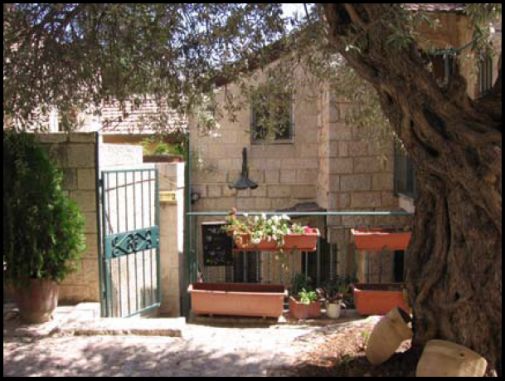
The steps and streets were made of cobblestones. The sides of the building were faced with hewn stones. There was a central parking area. Owners of each unit had to walk to their dwelling. I believe that the majority of units were on three levels like the one where we stayed. There were lawns and benches. There was a small synagogue.
The public had access to the area. We noticed that brides-to-be came in their wedding gowns and were photographed. While we were there, the area was never cluttered, crowded or noisy.
Within walking distance of the beautiful and exclusive residences are several landmarks – Montefiore’s Windmill, the YMCA, and the King David Hotel. And here is a bit of information from John’s travel guide:
Yemin Moshe (4)
Sir Mose Montefiore, a rich British Jewish philanthropist, was so shocked by the living conditions in the squalid Old City that he decided to improve the Jews’ lot by building new homes outside the walls. The first project was Mishkenot Shaananim (Dwellings of Tranquility), a communal block of sixteen apartments completed in 1860. Initially, people were afraid to move outside the security of the walls because of bandits, but by the end of the century, a small community called Yemin Moshe had been established nearby and was thriving. From this core, the vast spread of modern Jerusalem has grown. Yemin Moshe survives as its beautifully renovated historic heart. It is built on the slope of the valley facing the Old City walls, these early, attractive Oriental-style houses are now some of the most sought-after and exclusive residences in all Jerusalem. Pictured here is an overview of the neighborhood separated by 100 years of “progress.
A variety of historical and biographical sketches are available via the Internet. Key words that will connect with these sketches are the names Moses Montefiore, the Jewish philanthropist, whose generosity authored the area called Yemin Moshe where John and this author lodged for five days.
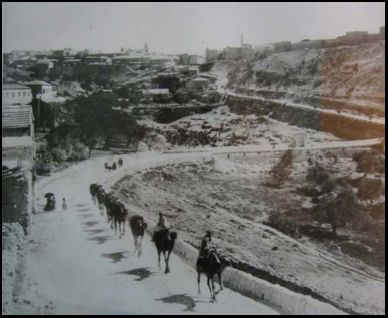
|
Yemin Moshe about 100 years ago.
|
|
Yemin Moshe today.
|
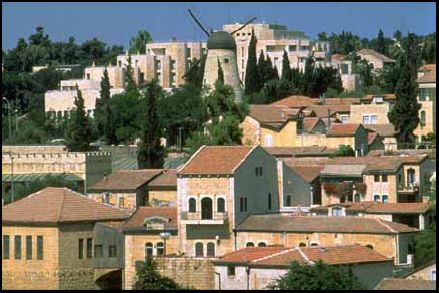
|
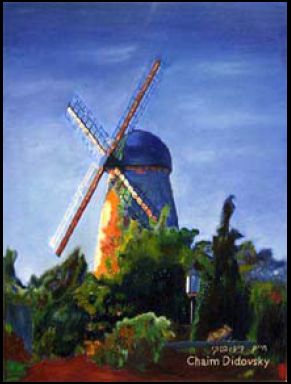
Painting of Montefiore’s Windmill
by Chaim Didovsky
|
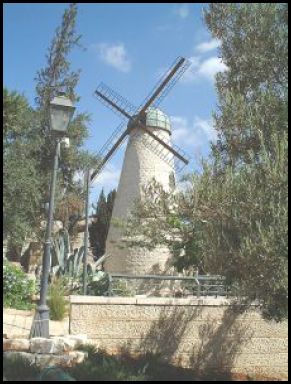
Actual photo of Montefiore’s Windmill
|
Montefiore’s Windmill (5)
Montefiore meant Mishkenot Shaananim to be self-sufficient, hence a windmill to grind the settlement’s own flour. Unfortunately, there was rarely enough wind to turn the sails. Montefiore’s Windmill has been a favorite subject for many artists.
There is a particular artist whose art and story deserves space in this manuscript. The artist can be contacted via his web site: www.kolrina.co.il/background.htm. His heartfelt story follows:
On Friday, 8.12.00, 11th of Kislev 5760, Rina Didovsky, a wife and mother of six, left her home to school where she worked as a teacher. Unusually, that morning, Rina drove in a non-armored car, which was not recommended in her area. She was in a hurry to arrive at her classroom on time.
Terrorists' bullets hit Rina's vehicle and took her life.Chaim Didovsky, Rina's husband and the owner of the news agency "Hakol Mehashetach", arrived at the murder scene in order to report the dramatic event. At this time, Chaim was unaware that he was reporting the death of his wife.
After mourning his wife, Chaim and his six children moved to live in Elkana. There began their struggle of adjusting to life without a wife and mother.
The news agency "Hakol Mehashetach" was renamed "Kol Rina" - "The Voice of Rina" in memory of Rina Didovsky.
Shortly after Rina's death, Chaim began to paint as part of his rehabilitation. With paintbrushes and colors he brings beautiful paintings to life, artworks which have received excellent reviews from professional artists.
In his paintings here are many Jewish characteristics and landscapes of Israel.
In addition to Israelis who are impressed by Chaim's outbursts of creativity, Jews throughout the Diaspora are intrigued as well
The "Kol Rina" Foundation has taken on itself to spread Chaim Didovsky's enchanting paintings and in this way help Chaim and his children cope with their new way of life.
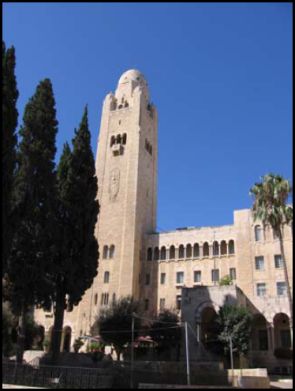
|
Built between 1926 and 1933 by Arthur Loomis Harmon, who also created New York’s Empire State Building, Jerusalem’s YMCA is one of the city’s best-known landmarks. It consists of three sections—the central body, dominated by a bell tower offering extraordinary views of the city, and the two side wings. The stone and wrought-iron decorative elements on the outside of the building, including the five-meter (16.5’) bas-relief of one of the six-winged seraphim described in the Old Testament (Isaiah 6:2-3), reflect a stylized form of Oriental Byzantine design, combined with elements of Romanesque and Islamic art.
Yet the exterior, splendid as it is, does not prepare the visitor for the fabulously elaborate décor on the inside. Here design elements from three different cultures are woven through with symbols from the three main monotheistic religions. In the concert hall, the dome’s twelve windows represent the Twelve Tribes of Israel, the Twelve Disciples of Christ and the Twelve Followers of Muhammad, while depicted on the chandelier are the Cross, Crescent and the Star of David. The entire creation has a kind of Art Deco gloss, while the ethos of its eclectic design is clearly one of peace and tolerance between faiths and culture. (5)
|
|
And here is a P.S. from Peter: The building houses an indoor and outdoor restaurant called, 3 ARCHES. The menus offer the dishes in three languages—English, Hebrew, and Arabic. John and I ate four out of our five evening meals at the restaurant. The ambiance was as wonderful as the food, enhanced by a glass of Burgundy. We were never disappointed. The weather was always mild and pleasant so that we chose to eat in the outdoor patio. The young servers, mostly girls—spoke English and were modest and pleasant to look at. They carried themselves with genuine poise.
Either before or after going to the 3 ARCHES, we phoned home. When it was 8:00 PM in Jerusalem, it was 10:00 AM in California. John’s cell phone worked everywhere in Jerusalem. He could hear the voice of his wife, Henrietta, and I could hear
|
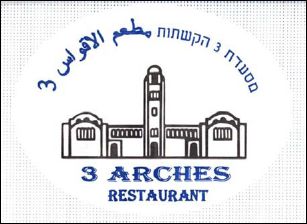
|
the voice of Rebekah like a clear bell. What a marvelous age we are living in!
KING DAVID HOTEL (7)
Eye-catching not least for its pink stone walls and green windows, this impressive 1930s hotel is a grandiose display of colonial architecture. It was designed by Swiss architect Emile Vogt for the Jewish-Egyptian Mosseri family.
Inside, the spacious lobbies and public areas with their discreet period wooden furnishings, reflect a sense of splendor from an altogether different era. The richly ornamental style is achieved through a mixture of various ancient architectural and decorative elements, including Egyptian, Phoenician, Assyrian and Greek, as well as aspects of Islamic art. The hotel boasts an impressive list of former guests, including Winston Churchill and Halle Selassie, and for a long time, part of the British Mandate administration was housed here.
In 1946 it was the target of a bomb attack perpetrated by the Zionist paramilitary terrorist group Irgun, led by Menachem Begin. It was rebuilt, and the two top floors were added later. (6)
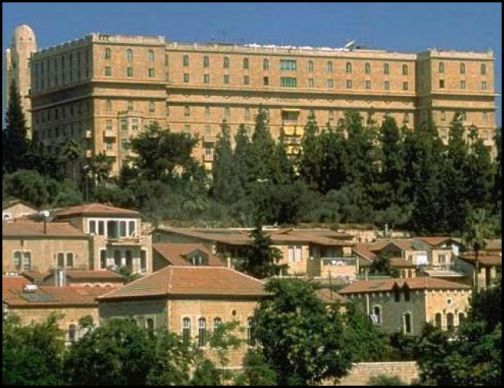
King David Hotel
I mentioned earlier, at the beginning of my report, that we spent Saturday, the 24th of September, touring the Arabic section of Jerusalem. I prefer not to go into additional details. It’s too hard to relive things that were so painful. Suffice to say, it was a difficult and threatening experience for John and myself, especially John, since he was more aware of the dark undercurrents towards foreigners and Jews in that part of the city.
|